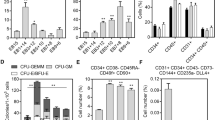Abstract
In vitro, the aggregation of pluripotent human embryonic stem cells (hESC) into cell clusters termed embryoid bodies (EB) allows for the spontaneous differentiation of hESC into progeny representing endoderm, mesoderm, and ectoderm lineages. During human EB (hEB) differentiation, stochastic emergence of hematopoietic cells can be enhanced by a combination of hematopoietic cytokines and the ventral mesoderm inducer bone morphogenetic protein (BMP)-4. Dependent on the presence of hematopoietic cytokines and BMP- 4, vascular endothelial growth factor (VEGF-A165) selectively promotes erythropoietic development toward the primitive lineage. The effects of VEGF-A165 can be augmented by erythropoietin (EPO). Hematopoietic cells are derived from a rare subpopulation of hemogenic precursors during hEB development. These hemogenic precursors lack CD45, but express PECAM-1, Flk-1, and VE-cadherin (hereinafter CD45negPFV) and are solely responsible for hematopoietic cell fate. Human ESC-derived hematopoietic cells have similar colony and cellular morphologies to those derived from committed adult hematopoietic tissues, and also show repopulating capacity in immune deficient mice after intrabone marrow transplantation. In this chapter, we describe methods that have been successfully applied in our laboratory, including (1) generation of hematopoietic cells by EB formation; (2) augmentation of hematopoiesis by use of hematopoietic cytokines and BMP-4; (3) promotion of erythropoietic development by addition of VEGF-A165 and EPO; (4) isolation of CD45negPFV hemogenic precursors and generation of hematopoietic cells from these precursors; and (5) characterization of hESC-derived hematopoietic cells in vitro and in vivo.
Access this chapter
Tax calculation will be finalised at checkout
Purchases are for personal use only
Similar content being viewed by others
References
Xu C., Inokuma M. S., Denham J., et al. (2001) Feeder-free growth of undifferentiated human embryonic stem cells. Nat. Biotechnol. 19, 971–974.
Schuldiner M., Yanuka O., Itskovitz-Eldor J., Melton D. A, and Benvenisty N. (2000) Effects of eight growth factors on the differentiation of cells derived from human embryonic stem cells. Proc. Natl. Acad. Sci. USA 97, 11307–11312.
Itskovitz-Eldor J., Schuldiner M., Karsenti D., et al. (2000) Differentiation of human embryonic stem cells into embryoid bodies compromising the three embryonic germ layers. Mol. Med. 6, 88–95.
Bhatia M. (2003) The ultimate source of human hematopoietic stem cells: thinking outside the marrow. Cloning Stem Cells 5, 89–97.
Chadwick K., Wang L., Li L., et al. (2003) Cytokines and BMP-4 promote hematopoietic differentiation of human embryonic stem cells. Blood 102, 906–915.
Cerdan C., Rouleau A., and Bhatia M. (2004) VEGF-A165 augments erythropoietic development from human embryonic stem cells. Blood 103, 2504–2512.
Wang L., Li L., Shojaei F., et al. (2004) Endothelial and hematopoietic cell fate of human embryonic stem cells originates from primitive endothelium with hemangioblastic properties. Immunity 20, 31–41.
Dick J. E., Bhatia M., Gan O., Kapp U., and Wang J. C. (1997) Assay of human stem cells by repopulation of NOD/SCID mice. Stem Cells 15, 199–203; discussion 204-207.
Wang L., Menendez P., Shojaei F., et al. (2005) Generation of hematopoietic repopulating cells from human embryonic stem cells independent of ectopic HOXB4 expression. J. Exp. Med. 201, 1603–1614.
Bhatia M., Bonnet D., Kapp U., Wang J. C., Murdoch B., and Dick J. E. (1997) Quantitative analysis reveals expansion of human hematopoietic repopulating cells after short-term ex vivo culture. J. Exp. Med. 186, 619–624.
Author information
Authors and Affiliations
Editor information
Editors and Affiliations
Rights and permissions
Copyright information
© 2006 Humana Press Inc.
About this protocol
Cite this protocol
Wang, L., Cerdan, C., Menendez, P., Bhatia, M. (2006). Derivation and Characterization of Hematopoietic Cells From Human Embryonic Stem Cells. In: Turksen, K. (eds) Human Embryonic Stem Cell Protocols. Methods In Molecular Biology, vol 331. Humana Press. https://doi.org/10.1385/1-59745-046-4:179
Download citation
DOI: https://doi.org/10.1385/1-59745-046-4:179
Publisher Name: Humana Press
Print ISBN: 978-1-58829-497-5
Online ISBN: 978-1-59745-046-1
eBook Packages: Springer Protocols




